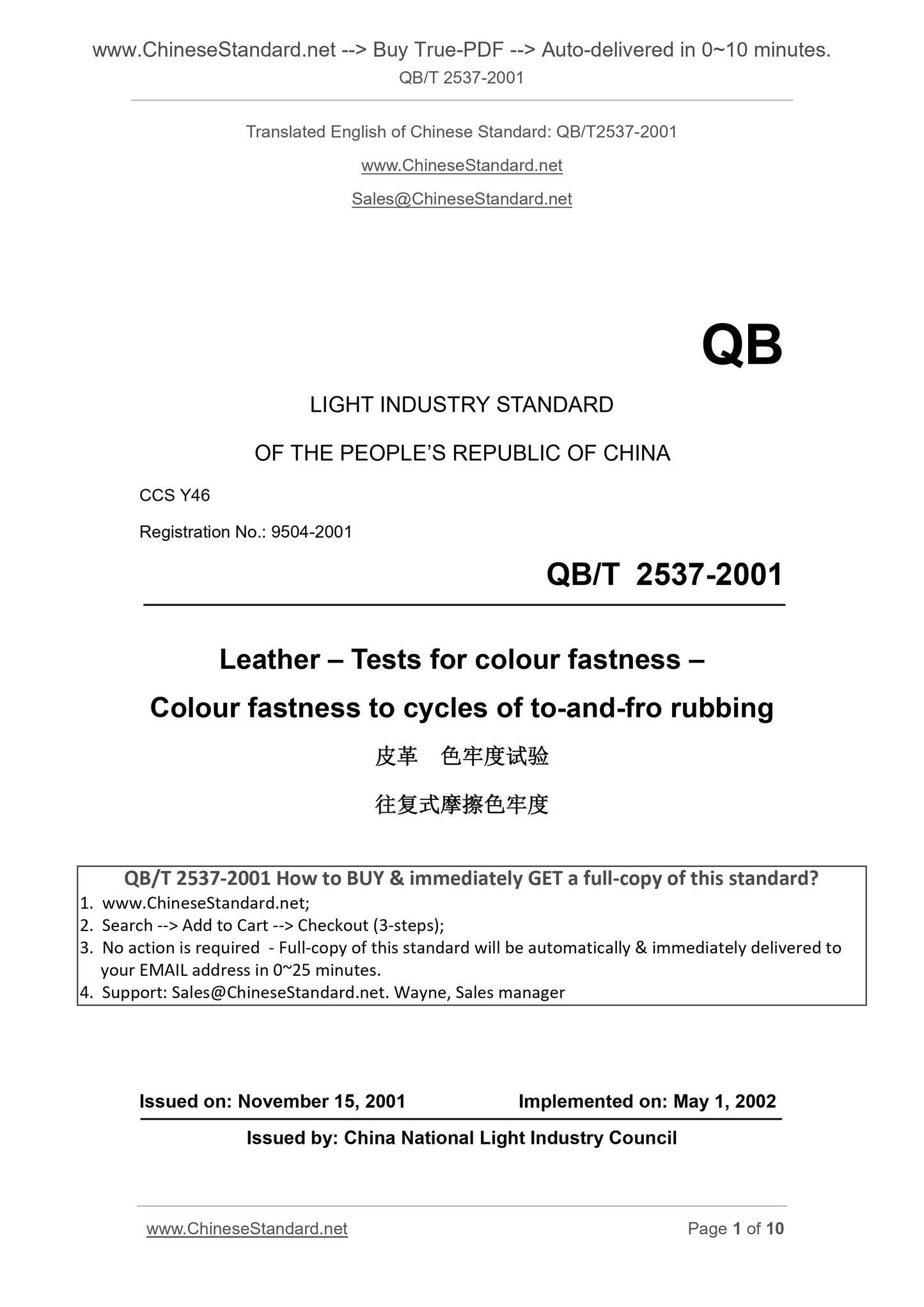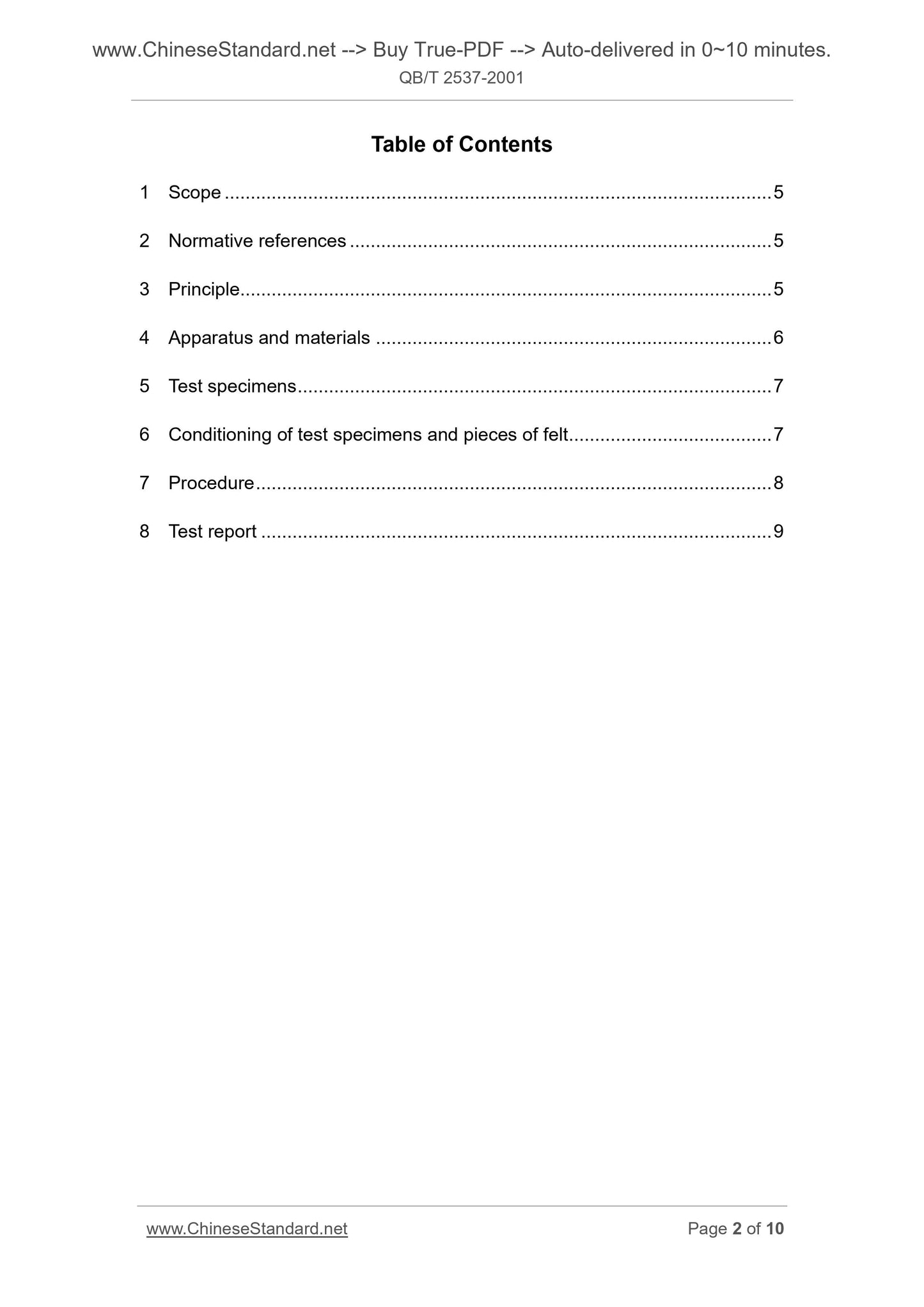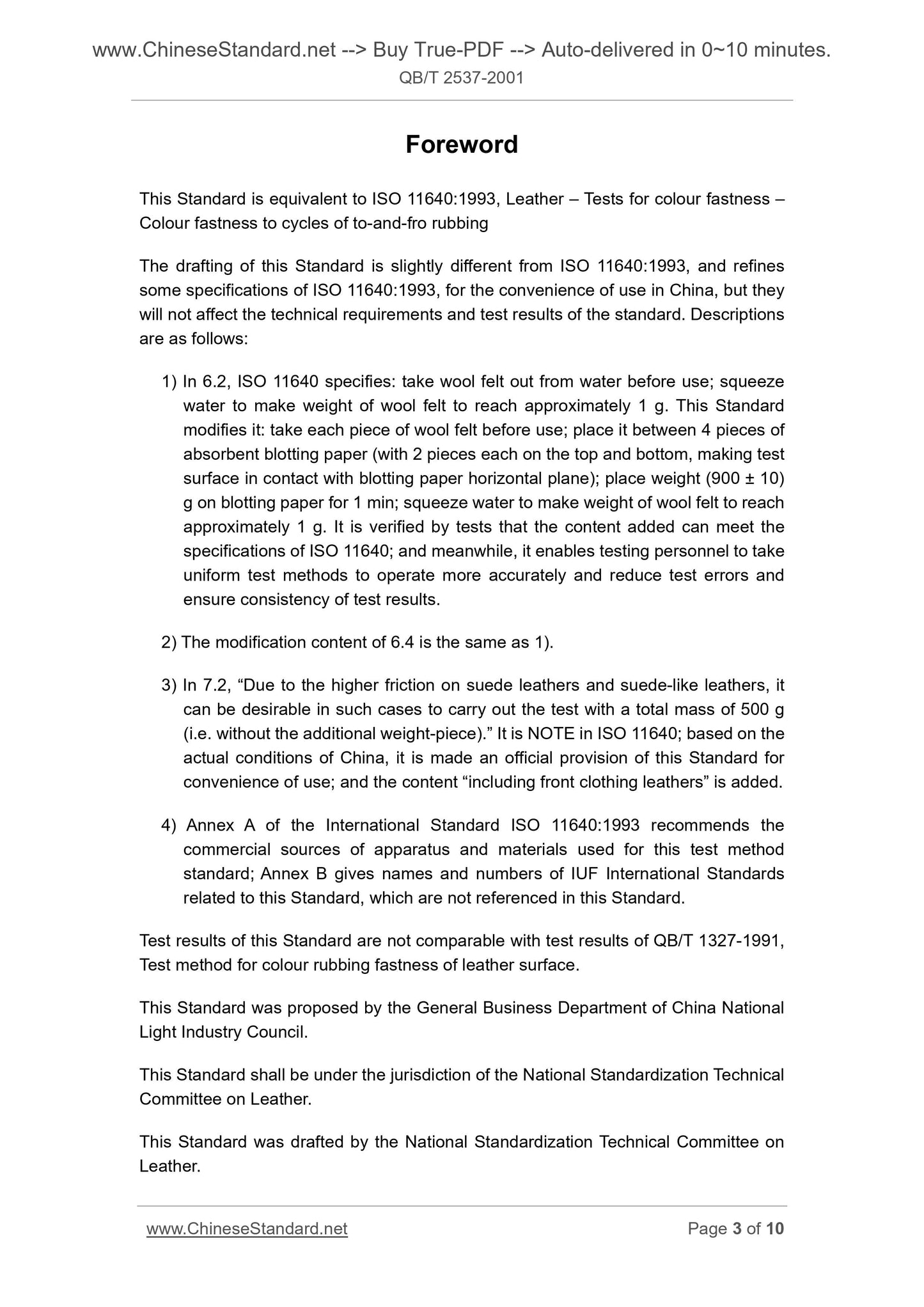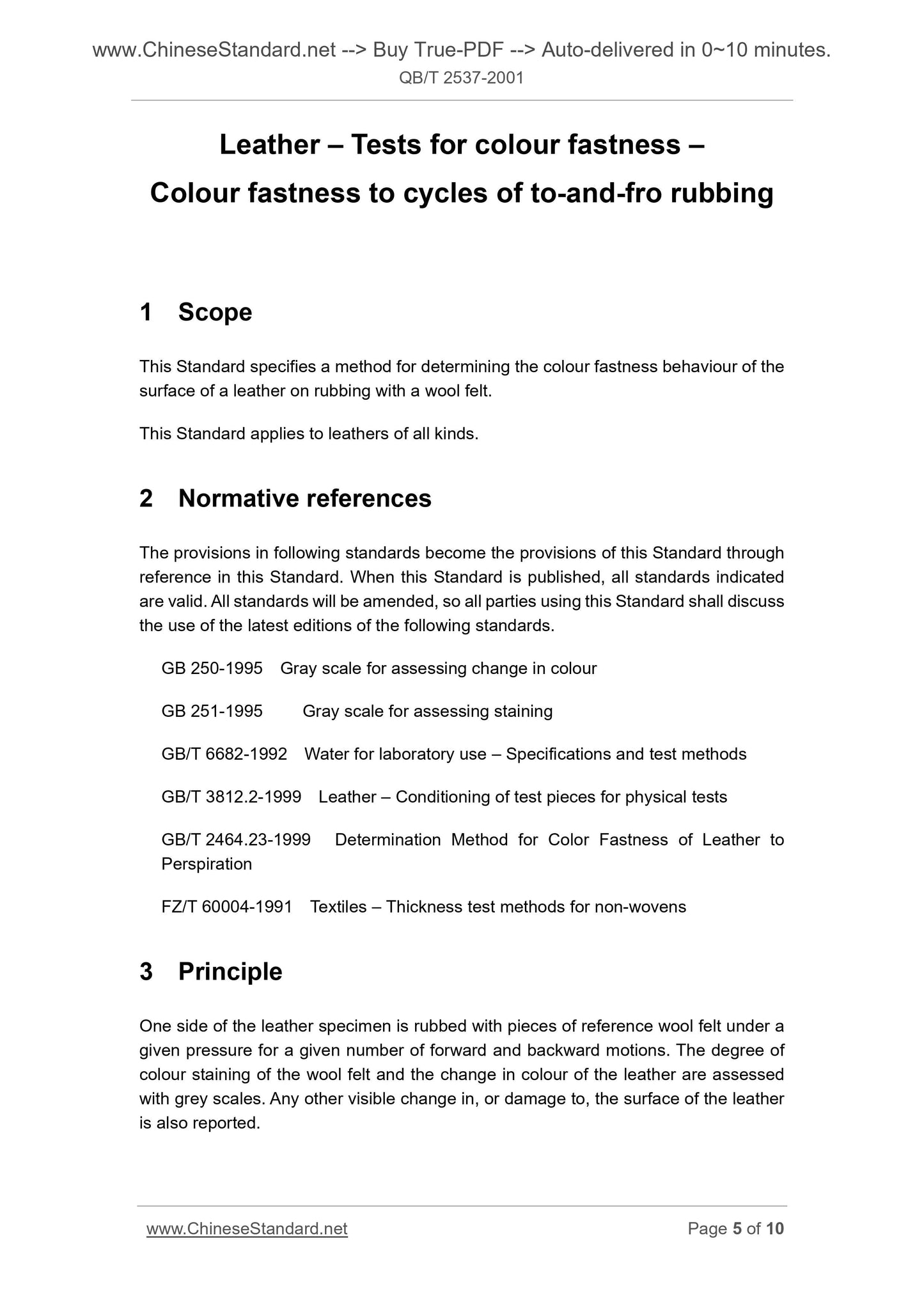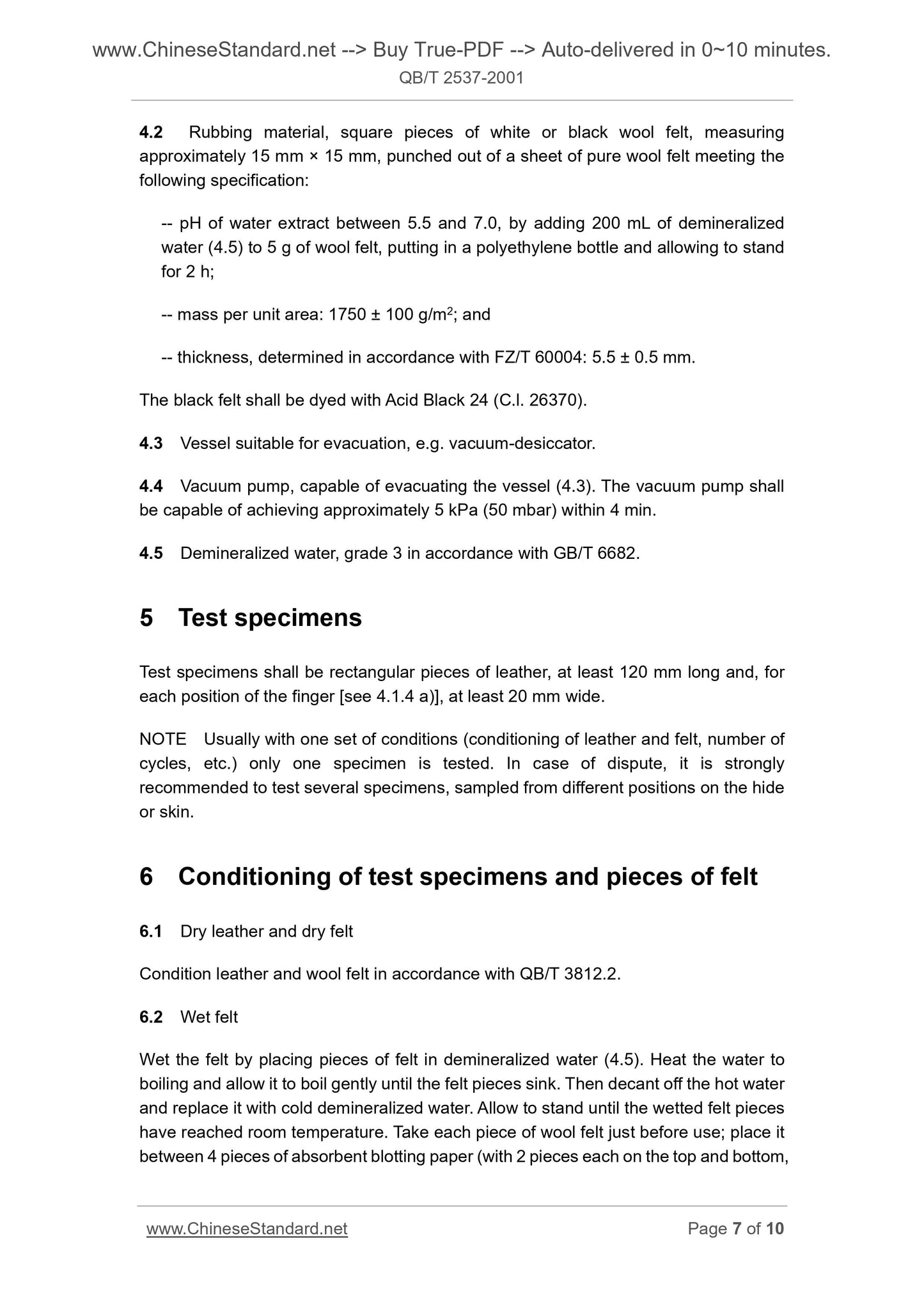1
/
of
5
PayPal, credit cards. Download editable-PDF and invoice in 1 second!
QB/T 2537-2001 English PDF (QBT2537-2001)
QB/T 2537-2001 English PDF (QBT2537-2001)
Regular price
$70.00 USD
Regular price
Sale price
$70.00 USD
Unit price
/
per
Shipping calculated at checkout.
Couldn't load pickup availability
Delivery: 3 seconds. Download true-PDF + Invoice.
Get QUOTATION in 1-minute: Click QB/T 2537-2001
Historical versions: QB/T 2537-2001
Preview True-PDF (Reload/Scroll if blank)
QB/T 2537-2001: Leather - Tests for colour fastness - Colour fastness to cycles of to-and-fro rubbing
QB/T 2537-2001
QB
LIGHT INDUSTRY STANDARD
OF THE PEOPLE’S REPUBLIC OF CHINA
CCS Y46
Registration No.. 9504-2001
Leather – Tests for colour fastness –
Colour fastness to cycles of to-and-fro rubbing
往复式摩擦色牢度
ISSUED ON. NOVEMBER 15, 2001
IMPLEMENTED ON. MAY 1, 2002
Issued by. China National Light Industry Council
Table of Contents
1 Scope ... 5
2 Normative references ... 5
3 Principle... 5
4 Apparatus and materials ... 6
5 Test specimens ... 7
6 Conditioning of test specimens and pieces of felt ... 7
7 Procedure ... 8
8 Test report ... 9
Foreword
This Standard is equivalent to ISO 11640.1993, Leather – Tests for colour fastness –
Colour fastness to cycles of to-and-fro rubbing
The drafting of this Standard is slightly different from ISO 11640.1993, and refines
some specifications of ISO 11640.1993, for the convenience of use in China, but they
will not affect the technical requirements and test results of the standard. Descriptions
are as follows.
1) In 6.2, ISO 11640 specifies. take wool felt out from water before use; squeeze
water to make weight of wool felt to reach approximately 1 g. This Standard
modifies it. take each piece of wool felt before use; place it between 4 pieces of
absorbent blotting paper (with 2 pieces each on the top and bottom, making test
surface in contact with blotting paper horizontal plane); place weight (900 ± 10)
g on blotting paper for 1 min; squeeze water to make weight of wool felt to reach
approximately 1 g. It is verified by tests that the content added can meet the
specifications of ISO 11640; and meanwhile, it enables testing personnel to take
uniform test methods to operate more accurately and reduce test errors and
ensure consistency of test results.
2) The modification content of 6.4 is the same as 1).
3) In 7.2, “Due to the higher friction on suede leathers and suede-like leathers, it
can be desirable in such cases to carry out the test with a total mass of 500 g
(i.e. without the additional weight-piece).” It is NOTE in ISO 11640; based on the
actual conditions of China, it is made an official provision of this Standard for
convenience of use; and the content “including front clothing leathers” is added.
4) Annex A of the International Standard ISO 11640.1993 recommends the
commercial sources of apparatus and materials used for this test method
standard; Annex B gives names and numbers of IUF International Standards
related to this Standard, which are not referenced in this Standard.
Test results of this Standard are not comparable with test results of QB/T 1327-1991,
Test method for colour rubbing fastness of leather surface.
This Standard was proposed by the General Business Department of China National
Light Industry Council.
This Standard shall be under the jurisdiction of the National Standardization Technical
Committee on Leather.
This Standard was drafted by the National Standardization Technical Committee on
Leather.
Leather – Tests for colour fastness –
Colour fastness to cycles of to-and-fro rubbing
1 Scope
This Standard specifies a method for determining the colour fastness behaviour of the
surface of a leather on rubbing with a wool felt.
This Standard applies to leathers of all kinds.
2 Normative references
The provisions in following standards become the provisions of this Standard through
reference in this Standard. When this Standard is published, all standards indicated
are valid. All standards will be amended, so all parties using this Standard shall discuss
the use of the latest editions of the following standards.
GB 250-1995 Gray scale for assessing change in colour
GB 251-1995 Gray scale for assessing staining
GB/T 6682-1992 Water for laboratory use – Specifications and test methods
GB/T 3812.2-1999 Leather – Conditioning of test pieces for physical tests
GB/T 2464.23-1999 Determination Method for Color Fastness of Leather to
Perspiration
FZ/T 60004-1991 Textiles – Thickness test methods for non-wovens
3 Principle
One side of the leather specimen is rubbed with pieces of reference wool felt under a
given pressure for a given number of forward and backward motions. The degree of
colour staining of the wool felt and the change in colour of the leather are assessed
with grey scales. Any other visible change in, or damage to, the surface of the leather
is also reported.
4.2 Rubbing material, square pieces of white or black wool felt, measuring
approximately 15 mm × 15 mm, punched out of a sheet of pure wool felt meeting the
following specification.
-- pH of water extract between 5.5 and 7.0, by adding 200 mL of demineralized
water (4.5) to 5 g of wool felt, putting in a polyethylene bottle and allowing to stand
for 2 h;
-- mass per unit area. 1750 ± 100 g/m2; and
-- thickness, determined in accordance with FZ/T 60004. 5.5 ± 0.5 mm.
The black felt shall be dyed with Acid Black 24 (C.l. 26370).
4.3 Vessel suitable for evacuation, e.g. vacuum-desiccator.
4.4 Vacuum pump, capable of evacuating the vessel (4.3). The vacuum pump shall
be capable of achieving approximately 5 kPa (50 mbar) within 4 min.
4.5 Demineralized water, grade 3 in accordance with GB/T 6682.
5 Test specimens
Test specimens shall be rectangular pieces of leather, at least 120 mm long and, for
each position of the finger [see 4.1.4 a)], at least 20 mm wide.
NOTE Usually with one set of conditions (conditioning of leather and felt, number of
cycles, etc.) only one specimen is tested. In case of dispute, it is strongly
recommended to test several specimens, sampled from different positions on the hide
or skin.
6 Conditioning of test specimens and pieces of felt
6.1 Dry leather and dry felt
Condition leather and wool felt in accordance with QB/T 3812.2.
6.2 Wet felt
Wet the felt by placing pieces of felt in demineralized water (4.5). Heat the water to
boiling and allow it to boil gently until the felt pieces sink. Then decant off the hot water
and replace it with cold demineralized water. Allow to stand until the wetted felt pieces
have reached room temperature. Take each piece of wool felt just before use; place it
between 4 pieces of absorbent blotting paper (with 2 pieces each on the top and bottom,
Get QUOTATION in 1-minute: Click QB/T 2537-2001
Historical versions: QB/T 2537-2001
Preview True-PDF (Reload/Scroll if blank)
QB/T 2537-2001: Leather - Tests for colour fastness - Colour fastness to cycles of to-and-fro rubbing
QB/T 2537-2001
QB
LIGHT INDUSTRY STANDARD
OF THE PEOPLE’S REPUBLIC OF CHINA
CCS Y46
Registration No.. 9504-2001
Leather – Tests for colour fastness –
Colour fastness to cycles of to-and-fro rubbing
往复式摩擦色牢度
ISSUED ON. NOVEMBER 15, 2001
IMPLEMENTED ON. MAY 1, 2002
Issued by. China National Light Industry Council
Table of Contents
1 Scope ... 5
2 Normative references ... 5
3 Principle... 5
4 Apparatus and materials ... 6
5 Test specimens ... 7
6 Conditioning of test specimens and pieces of felt ... 7
7 Procedure ... 8
8 Test report ... 9
Foreword
This Standard is equivalent to ISO 11640.1993, Leather – Tests for colour fastness –
Colour fastness to cycles of to-and-fro rubbing
The drafting of this Standard is slightly different from ISO 11640.1993, and refines
some specifications of ISO 11640.1993, for the convenience of use in China, but they
will not affect the technical requirements and test results of the standard. Descriptions
are as follows.
1) In 6.2, ISO 11640 specifies. take wool felt out from water before use; squeeze
water to make weight of wool felt to reach approximately 1 g. This Standard
modifies it. take each piece of wool felt before use; place it between 4 pieces of
absorbent blotting paper (with 2 pieces each on the top and bottom, making test
surface in contact with blotting paper horizontal plane); place weight (900 ± 10)
g on blotting paper for 1 min; squeeze water to make weight of wool felt to reach
approximately 1 g. It is verified by tests that the content added can meet the
specifications of ISO 11640; and meanwhile, it enables testing personnel to take
uniform test methods to operate more accurately and reduce test errors and
ensure consistency of test results.
2) The modification content of 6.4 is the same as 1).
3) In 7.2, “Due to the higher friction on suede leathers and suede-like leathers, it
can be desirable in such cases to carry out the test with a total mass of 500 g
(i.e. without the additional weight-piece).” It is NOTE in ISO 11640; based on the
actual conditions of China, it is made an official provision of this Standard for
convenience of use; and the content “including front clothing leathers” is added.
4) Annex A of the International Standard ISO 11640.1993 recommends the
commercial sources of apparatus and materials used for this test method
standard; Annex B gives names and numbers of IUF International Standards
related to this Standard, which are not referenced in this Standard.
Test results of this Standard are not comparable with test results of QB/T 1327-1991,
Test method for colour rubbing fastness of leather surface.
This Standard was proposed by the General Business Department of China National
Light Industry Council.
This Standard shall be under the jurisdiction of the National Standardization Technical
Committee on Leather.
This Standard was drafted by the National Standardization Technical Committee on
Leather.
Leather – Tests for colour fastness –
Colour fastness to cycles of to-and-fro rubbing
1 Scope
This Standard specifies a method for determining the colour fastness behaviour of the
surface of a leather on rubbing with a wool felt.
This Standard applies to leathers of all kinds.
2 Normative references
The provisions in following standards become the provisions of this Standard through
reference in this Standard. When this Standard is published, all standards indicated
are valid. All standards will be amended, so all parties using this Standard shall discuss
the use of the latest editions of the following standards.
GB 250-1995 Gray scale for assessing change in colour
GB 251-1995 Gray scale for assessing staining
GB/T 6682-1992 Water for laboratory use – Specifications and test methods
GB/T 3812.2-1999 Leather – Conditioning of test pieces for physical tests
GB/T 2464.23-1999 Determination Method for Color Fastness of Leather to
Perspiration
FZ/T 60004-1991 Textiles – Thickness test methods for non-wovens
3 Principle
One side of the leather specimen is rubbed with pieces of reference wool felt under a
given pressure for a given number of forward and backward motions. The degree of
colour staining of the wool felt and the change in colour of the leather are assessed
with grey scales. Any other visible change in, or damage to, the surface of the leather
is also reported.
4.2 Rubbing material, square pieces of white or black wool felt, measuring
approximately 15 mm × 15 mm, punched out of a sheet of pure wool felt meeting the
following specification.
-- pH of water extract between 5.5 and 7.0, by adding 200 mL of demineralized
water (4.5) to 5 g of wool felt, putting in a polyethylene bottle and allowing to stand
for 2 h;
-- mass per unit area. 1750 ± 100 g/m2; and
-- thickness, determined in accordance with FZ/T 60004. 5.5 ± 0.5 mm.
The black felt shall be dyed with Acid Black 24 (C.l. 26370).
4.3 Vessel suitable for evacuation, e.g. vacuum-desiccator.
4.4 Vacuum pump, capable of evacuating the vessel (4.3). The vacuum pump shall
be capable of achieving approximately 5 kPa (50 mbar) within 4 min.
4.5 Demineralized water, grade 3 in accordance with GB/T 6682.
5 Test specimens
Test specimens shall be rectangular pieces of leather, at least 120 mm long and, for
each position of the finger [see 4.1.4 a)], at least 20 mm wide.
NOTE Usually with one set of conditions (conditioning of leather and felt, number of
cycles, etc.) only one specimen is tested. In case of dispute, it is strongly
recommended to test several specimens, sampled from different positions on the hide
or skin.
6 Conditioning of test specimens and pieces of felt
6.1 Dry leather and dry felt
Condition leather and wool felt in accordance with QB/T 3812.2.
6.2 Wet felt
Wet the felt by placing pieces of felt in demineralized water (4.5). Heat the water to
boiling and allow it to boil gently until the felt pieces sink. Then decant off the hot water
and replace it with cold demineralized water. Allow to stand until the wetted felt pieces
have reached room temperature. Take each piece of wool felt just before use; place it
between 4 pieces of absorbent blotting paper (with 2 pieces each on the top and bottom,
Share
